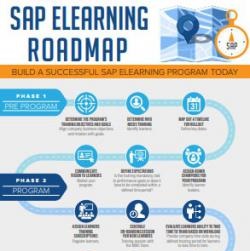How to Budget for SAP Training This Year
by Thomas Michael
 Get ready, it’s that time of year again…no, I don’t mean spooky Halloween costumes – it’s budgeting season! And if you are in charge of putting together an SAP training program at your company you’ve probably been dreading this for a while. No problem, allow me to help.
Get ready, it’s that time of year again…no, I don’t mean spooky Halloween costumes – it’s budgeting season! And if you are in charge of putting together an SAP training program at your company you’ve probably been dreading this for a while. No problem, allow me to help.
Some of the questions you might have been asking yourself are:
- Who in our organization is supposed to get SAP training?
- On what modules? End user or configuration training?
- Do we have to create this ourselves or can we buy ready-to-go content?
- How much is this going to cost?
- And if we have to create our own training material – how long is this going to take and who will actually do it?
- How will we measure an ROI for our training program to keep the big wigs happy?
All good questions…each could take hours to discuss and figure out. So let me give you a few shortcuts based on my 20+ years in the SAP industry (and based on our 300+ corporate customers and 30,000+ students).
How many of our employees will need SAP training?
Let’s say you have 400 licensed SAP users…without knowing anything else about your company I can tell you that about half (=200 users) will need training next year. How do I know?
Well, the average attrition rate in the SAP world is about 25%...that means, about 100 people will leave the organization, retire, change jobs, new hires, etc. – all these folks need the full training program starting with the basics.
Then there’s probably another 25% of folks that have been with your company for a couple of years or so. They are no newbies but not experts either – they certainly do not need the fundamental SAP training anymore but could use more in-depth training related to their specific job role. And then you probably have another 10% or so of people that are really seasoned SAP experts but still want to learn new functionality and features.
What kind of SAP training will they need?
New hires and other SAP beginners will need basic SAP training (think, basic overview, navigation, and reporting skills) plus in-depth, job-specific training (accountants will need accounting training, procurement needs to learn SAP Purchasing, etc. – you get my point). Other folks will need (or want) more intermediate to expert-level training for their SAP career paths or want to cross-train for related functions (think accounts payable vs. receivable).
How much training is enough?
New SAP users will need 40-60+ hours to cover basic SAP skills plus their job-related training. Seasoned SAP users looking for expert SAP training will probably clock in around 15-20 hours/year. Everyone else falls somewhere in the middle.
We benchmarked 5,000 students and found that the average among all our corporate customers is between 35-40 hours per student and year.
Can we use ready-to-go courses or do we have to create this ourselves?
80% or more of an SAP user’s skillset is generic in nature (meaning, it is not specific to a company). For example, all basic navigation and reporting skills are pretty much the same, no matter what company you work for. Also, the basic way to create a customer master record or post an invoice or edit a purchase requisition is very much alike from one company to another (no matter how much everybody thinks they are different).
However, there’s about 20% or so (depending on your company’s level of customization) that is, in fact, specific to your organization. With this in mind, you should try to avoid creating custom content for generic skills. Creating custom training material is incredibly time-consuming and expensive. Instead, spend your training dollars wisely on top quality 3rd party content.
How much is this going to cost?
It really depends on how many users you need to train…unlimited online training subscriptions are around $1600-$2000 per user but this price scales nicely with higher volume. On average, I’d budget anywhere from $400-800 per user/year (depending on the number of students, of course). Smaller organizations with fewer SAP users will pay more while large organizations with 500+ users will end up paying less.
And if you still insist on the old classroom training method figure about $700 per user/day plus travel expenses and absences (it’s the most expensive way to provide training and the least effective, just FYI).
If you want to create your own content we have a great infographic that shows all the people you will need in the development process plus the associated costs/hours required – you’ll be stunned by these numbers – check it out: What does it take to develop your own SAP training?
How will we measure training ROI?
With modern online SAP training, you can measure just about anything you want. With our premium SAP training analytics you can make sure the bosses will be happy. Usage rates? Check. Course completions? Yup. Exam scores? Oh yeah. And so much more. Put all these metrics together and you can actually measure the impact the training will have on your organization.
Again, we could spend days trying to figure this all out (and you probably will have to do that) but the list above will get you 90% there without having to spend excessive hours coming up with some budget numbers for next year.
Hope this was helpful – please comment in the section below.
by Thomas Michael
More Blogs by Thomas Michael

MMC Cares Joins The 1% Pledge
MMC Cares is the corporate social responsibility (CSR) program of the ...


Download all SAP transaction codes
Our customer service team was just asked if we had an SAP transact...
Related Blogs

Learn the Musashi Approach to Making SAP Training Stick
We interviewed Tom Adkins, the training coordinator of Musashi, winner...

Tasty SAP training - How to make it more palatable for...
How is your corporate SAP training program doing? Over our years of de...

Roadmap to Successful SAP Training
Yes, it is that busy season again… with everything from year-end...
.png)

